Nature Notes
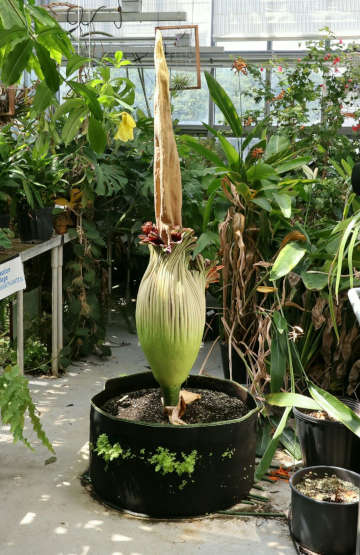
PHOTO COURTESY OF GARRY KESSLER
Corpse flower (Titan arum, Amorphophallus titanium) in bloom in the Wheaton College greenhouse in July.
August 15, 2023
NATURE NOTES
By Annie Reid and Scott Shumway (Department of Biology, Wheaton College, Norton, MA)
Westborough Community Land Trust
Corpse flower & local relatives
Did you ever wonder what interesting relatives your houseplants might have? Take common houseplants such as anthuriums (Anthurium) and peace lilies (Spathiphyllum). Their relatives include our local wild plants, skunk cabbage and jack-in-the-pulpit. And would you believe, they also include corpse flower (Titan arum, Amorphophallus titanum)? From the rainforests of Sumatra in Indonesia, this giant plant bloomed briefly and dramatically in July in the greenhouse at Wheaton College (Norton, MA).
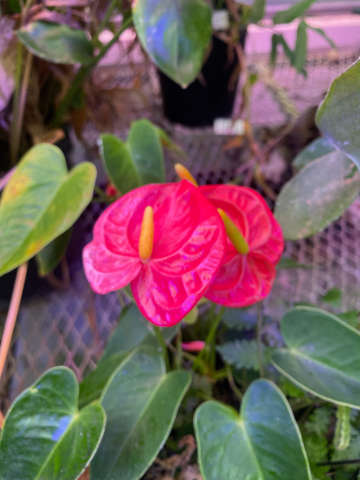
PHOTO COURTESY OF BENJAMIN ROBBINS
Common anthurium houseplant in bloom.
As relatives, these five diverse plants are alike in various ways. You can see one way when the plants bloom. The flowering stalk (spadix) is a fleshy spike, such as you might admire on an anthurium or peace lily. It’s covered with tiny flowers. There’s also a leaf-like part (spathe) that may partially wrap around the spike.
When our native skunk cabbage (Symplocarpus foetidus) and jack-in-the-pulpit (Arisaema triphyllum) bloom in spring, you can see other versions of the spike and protective leaf. Even before the typical skunk cabbage leaves come up in early spring, the leaf-like but fleshy, pointed hoods poke up. These red-brown hoods shelter a chunky knob covered with many tiny flowers.
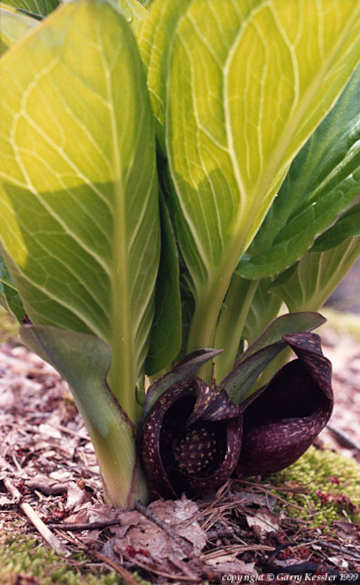
PHOTO COURTESY OF GARRY KESSLER
Skunk cabbage, a local wetland plant, in bloom in spring.
In May or June, jack-in-the-pulpit plants appear and bloom. You can see how they resemble an old-fashioned pulpit with a "preacher" inside. The preacher is the spike with tiny flowers, and the pulpit is the protective leaf. Above that, two three-parted green leaves shade the pulpit. The plants grow one to two feet high.
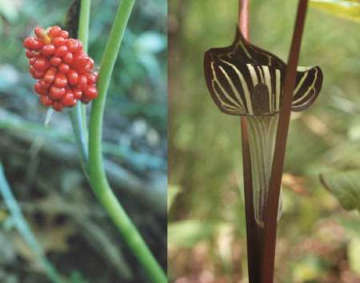
PHOTO COURTESY OF GARRY KESSLER
Jack-in-the-pulpit, a local woodland plant, blooms in spring and produces a cluster of berries (inedible) in the fall.
And then there’s the corpse flower. This exotic tropical giant typically blooms for 2-3 days after many years of repeatedly producing huge leaves (6-plus feet tall) and then dying back to the ground, only to start the process again. In blooming, it produces a 4- to 6-foot spike (spadix) wrapped at the bottom by the large leaf-like part (spathe), which opens up to reveal a purple-brown inner surface and tiny bump-like flowers.
When corpse flower blooms, you know right away why it has this name. Its flowers release an odor of rotting flesh. This scent is a clue to its kinship with skunk cabbage, all parts of which give off an odor of skunk when bruised or stepped on. Also, in both plants, the flowering spike produces heat. Why the odor and heat? Together, they help to attract the flies, beetles, and other insects that pollinate the flowers.
If pollinated, both corpse flower and its other local relative, jack-in-the-pulpit, produce clusters of orange-red berries. (In early September, look for jack-in-the-pulpit berries in local woods, but don’t eat them.) Birds eat the berries and spread the seeds in their droppings.
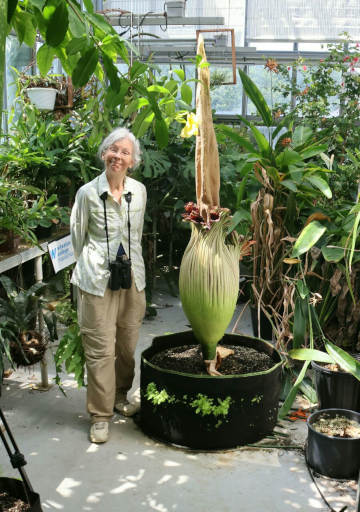
PHOTO COURTESY OF GARRY KESSLER
Corpse flower in bloom towered over visitors.
The corpse flower in the Wheaton greenhouse in Norton, MA was not pollinated. Why? There was only the one plant in bloom – no other to provide genetically different pollen. In most years, when not blooming, the corpse flower plant looks tree-like, but what you’d see is really a giant leaf. It can grow more than 6 feet tall. It comes up as a stalk with a three-parted leaf blade that divides into what looks like many leaflets.
After months of turning sunlight into carbohydrates, the plant dies back and regrows again. It stores its carbs underground in a corm, much as familiar bulb plants like tulips, gladiolas, and dahlias do. After several years, the corm can weigh 50-100 pounds, and the plant will have stored enough energy to bloom again.
Skunk cabbage and jack-in-the-pulpit plants are doing well in our local wetlands and woodlands (see Nature Notes 26 and Nature Notes 4). Unfortunately, the corpse flower’s rainforest habitat is one of the most threatened on the planet. Threats include deforestation and the conversion of rainforest to oil palm plantations. Corpse flower (Titan Arum) is listed as globally “endangered” on the IUCN Red List. (The International Union for Conservation of Nature’s Red List is the endangered species list for the world.)
Enjoy the five plants mentioned here. They’re in the Arum family (Araceae) of flowering plants, which contains more than 3,500 species worldwide. Check out the Wheaton greenhouse in Norton, MA. It’s is open to the public most weekdays during the school year. The corpse flower, however, may not bloom again for another 10 years.
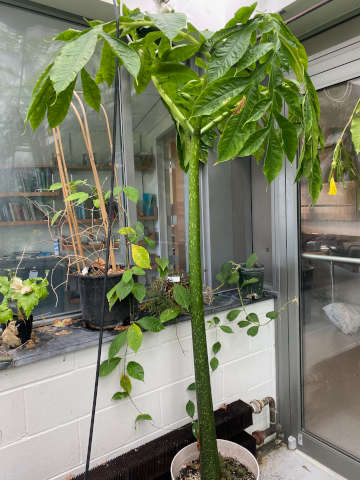
PHOTO COURTESY OF BENJAMIN ROBBINS
Corpse flower plant in its tree-like form.